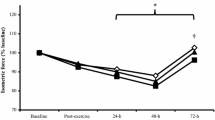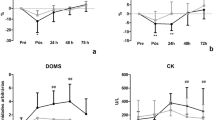Abstract
The purpose of this study was to determine the effect of leucine supplementation on indices of muscle damage following eccentric-based resistance exercise. In vitro, the amino acid leucine has been shown to reduce proteolysis and stimulate protein synthesis. Twenty-seven untrained males (height 178.6 ± 5.5 cm; body mass 77.7 ± 13.5 kg; age 21.3 ± 1.6 years) were randomly divided into three groups; leucine (L) (n = 10), placebo (P) (n = 9) and control (C) (n = 8). The two experimental groups (L and P) performed 100 depth jumps from 60 cm and six sets of ten repetitions of eccentric-only leg presses. Either leucine (250 mg/kg bm) or placebo was ingested 30 min before, during and immediately post-exercise and the morning of each recovery day following exercise. Muscle function was determined by peak force during an isometric squat and by jump height during a static jump at pre-exercise (PRE) and 24, 48, 72, and 96 h post-exercise (24, 48, 72, 96 h). Additionally, at these time points each group’s serum levels of creatine kinase (CK) and myoglobin (Mb) along with perceived feelings of muscle soreness were determined. None of the C group dependent variables was altered by the recurring testing procedures. Peak force was significantly decreased across all time points for both experimental groups. The L group experienced an attenuated drop in mean peak force across all post-exercise time points compared to the P group. Jump height significantly decreased from PRE for both the L and P group at 24 h and 48 h. CK and Mb was significantly elevated from PRE for both experimental groups at 24 h. Muscle soreness increased across all time points for the both the L and P group, and the L group experienced a significantly higher increase in mean muscle soreness post-exercise. Following exercise-induced muscle damage, high-dose leucine supplementation may help maintain force output during isometric contractions, however, not force output required for complex physical tasks thereby possibly limiting its ergogenic effectiveness.





Similar content being viewed by others
References
Anthony JC, Anthony TG, Kimball SR, Vary TC, Jefferson LS (2000) Orally administered leucine stimulates protein synthesis in skeletal muscle of postabsorptive rats in association with increased eIF4F formation. J Nutr 130(2):139–145
Bassit RA, Sawada LA, Bacurau RF, Navarro F, Martins E Jr, Santos RV, Caperuto EC, Rogeri P, Costa Rosa LF (2002) Branched-chain amino acid supplementation and the immune response of long-distance athletes. Nutrition 18(5):376–379
Baty JJ, Hwang H, Ding Z, Bernard JR, Wang B, Kwon B, Ivy JL (2007) The effect of a carbohydrate and protein supplement on resistance exercise performance, hormonal response, and muscle damage. J Strength Cond Res 21(2):321–329
Blomstrand E, Eliasson J, Karlsson HK, Kohnke R (2006) Branched-chain amino acids activate key enzymes in protein synthesis after physical exercise. J Nutr 136(1 Suppl):269S–273S
Brancaccio P, Maffulli N, Limongelli FM (2007) Creatine kinase monitoring in sport medicine. Br Med Bull 81–82:209–230
Buford TW, Cooke MB, Shelmadine BD, Hudson GM, Redd L, Willoughby DS (2009) Effects of eccentric treadmill exercise on inflammatory gene expression in human skeletal muscle. Appl Physiol Nutr Metab 34(4):745–753
Buse MG, Reid SS (1975) Leucine. A possible regulator of protein turnover in muscle. J Clin Investig 56(5):1250–1261
Byrne C, Eston R (2002) The effect of exercise-induced muscle damage on isometric and dynamic knee extensor strength and vertical jump performance. J Sports Sci 20(5):417–425
Cockburn E, Hayes PR, French DN, Stevenson E, Clair Gibson A (2008) Acute milk-based protein-CHO supplementation attenuates exercise-induced muscle damage. Appl Physiol Nutr Metab 33(4):775–783
Cooke MB, Rybalka E, Williams AD, Cribb PJ, Hayes A (2009) Creatine supplementation enhances muscle force recovery after eccentrically induced muscle damage in healthy individuals. J Int Soc Sports Nutr 6:13
Coombes JS, McNaughton LR (2000) Effects of branched-chain amino acid supplementation on serum creatine kinase and lactate dehydrogenase after prolonged exercise. J Sports Med Phys Fitness 40(3):240–246
Cormie P, McBride JM, McCaulley GO (2007) Validation of power measurement techniques in dynamic lower body resistance exercises. J Appl Biomech 23(2):103–118
Ebbeling CB, Clarkson PM (1989) Exercise-induced muscle damage and adaptation. Sports Med 7(4):207–234
Gibala MJ, MacDougall JD, Tarnopolsky MA, Stauber WT, Elorriaga A (1995) Changes in human skeletal muscle ultrastructure and force production after acute resistance exercise. J Appl Physiol 78(2):702–708
Greer BK, Woodard JL, White JP, Arguello EM, Haymes EM (2007) Branched-chain amino acid supplementation and indicators of muscle damage after endurance exercise. Int J Sport Nutr Exerc Metab 17(6):595–607
Harrison AJ, Gaffney SD (2004) Effects of muscle damage on stretch-shortening cycle function and muscle stiffness control. J Strength Cond Res 18(4):771–776
Jackman SR, Witard OC, Jeukendrup AE, Tipton KD (2010) Branched-chain amino acid ingestion can ameliorate soreness from eccentric exercise. Med Sci Sports Exerc 42(5):962–970
MacIntyre DL, Sorichter S, Mair J, Berg A, McKenzie DC (2001) Markers of inflammation and myofibrillar proteins following eccentric exercise in humans. Eur J Appl Physiol 84(3):180–186
McBride JM, Blow D, Kirby TJ, Haines TL, Dayne AM, Triplett NT (2009) Relationship between maximal squat strength and five, ten, and forty yard sprint times. J Strength Cond Res 23(6):1633–1636
Miyama M, Nosaka K (2004) Influence of surface on muscle damage and soreness induced by consecutive drop jumps. J Strength Cond Res 18(2):206–211
Nakashima K, Ishida A, Yamazaki M, Abe H (2005) Leucine suppresses myofibrillar proteolysis by down-regulating ubiquitin-proteasome pathway in chick skeletal muscles. Biochem Biophys Res Commun 336(2):660–666
Nosaka K, Sacco P, Mawatari K (2006) Effects of amino acid supplementation on muscle soreness and damage. Int J Sport Nutr Exerc Metab 16(6):620–635
Nunan D, Howatson G, van Someren KA (2010) Exercise-induced muscle damage is not attenuated by beta-hydroxy-beta-methylbutyrate and alpha-ketoisocaproic acid supplementation. J Strength Cond Res 24(2):531–537
Peake J, Nosaka K, Suzuki K (2005) Characterization of inflammatory responses to eccentric exercise in humans. Exerc Immunol Rev 11:64–85
Pearce AJ, Sacco P, Byrnes ML, Thickbroom GW, Mastaglia FL (1998) The effects of eccentric exercise on neuromuscular function of the biceps brachii. J Sci Med Sport 1(4):236–244
Sharp CP, Pearson DR (2010) Amino acid supplements and recovery from high-intensity resistance training. J Strength Cond Res 24(4):1125–1130
Shimomura Y, Yamamoto Y, Bajotto G, Sato J, Murakami T, Shimomura N, Kobayashi H, Mawatari K (2006) Nutraceutical effects of branched-chain amino acids on skeletal muscle. J Nutr 136(2):529S–532S
Shimomura Y, Inaguma A, Watanabe S, Yamamoto Y, Muramatsu Y, Bajotto G, Sato J, Shimomura N, Kobayashi H, Mawatari K (2010) Branched-chain amino acid supplementation before squat exercise and delayed-onset muscle soreness. Int J Sport Nutr Exerc Metab 20(3):236–244
Smith C, Kruger MJ, Smith RM, Myburgh KH (2008) The inflammatory response to skeletal muscle injury: illuminating complexities. Sports Med 38(11):947–969
Stock MS, Young JC, Golding LA, Kruskall LJ, Tandy RD, Conway-Klaassen JM, Beck TW (2010) The effects of adding leucine to pre and postexercise carbohydrate beverages on acute muscle recovery from resistance training. J Strength Cond Res 24(8):2211–2219
Turner TS, Tucker KJ, Rogasch NC, Semmler JG (2008) Impaired neuromuscular function during isometric, shortening, and lengthening contractions after exercise-induced damage to elbow flexor muscles. J Appl Physiol 105(2):502–509
Van Koevering M, Nissen S (1992) Oxidation of leucine and alpha-ketoisocaproate to beta-hydroxy-beta-methylbutyrate in vivo. Am J Physiol 262 (1 Pt 1):E27–31
van Someren KA, Edwards AJ, Howatson G (2005) Supplementation with beta-hydroxy-beta-methylbutyrate (HMB) and alpha-ketoisocaproic acid (KIC) reduces signs and symptoms of exercise-induced muscle damage in man. Int J Sport Nutr Exerc Metab 15(4):413–424
White JP, Wilson JM, Austin KG, Greer BK, St John N, Panton LB (2008) Effect of carbohydrate-protein supplement timing on acute exercise-induced muscle damage. J Int Soc Sports Nutr 5:5
Yamamoto LM, Judelson DA, Farrell MJ, Lee EC, Armstrong LE, Casa DJ, Kraemer WJ, Volek JS, Maresh CM (2008) Effects of hydration state and resistance exercise on markers of muscle damage. J Strength Cond Res 22(5):1387–1393
Acknowledgments
This investigation was supported through the GNC® Nutritional Research Grant provided by the National Strength and Conditioning Association.
Author information
Authors and Affiliations
Corresponding author
Rights and permissions
About this article
Cite this article
Kirby, T.J., Triplett, N.T., Haines, T.L. et al. Effect of leucine supplementation on indices of muscle damage following drop jumps and resistance exercise. Amino Acids 42, 1987–1996 (2012). https://doi.org/10.1007/s00726-011-0928-9
Received:
Accepted:
Published:
Issue Date:
DOI: https://doi.org/10.1007/s00726-011-0928-9




